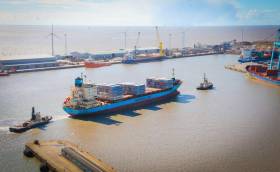Displaying items by tag: Maersk Larger Ship
#LargerShip - Maersk subsidiary Seago Line has introduced a larger capacity load-on /load-off (lo-lo) containership to its recently created feeder service calling at Dublin Port, writes Jehan Ashmore.
The Independent Accord (2007/20,995gt) operates the new container route between Algeciras-Liverpool-Dublin that began in April. The vessel has a 1,579TEU which is more than her predecessor, Antwerp with 1,058TEU that launched the service.
This morning, Independent Accord is offshore of Land’s End, Cornwall, bound for Liverpool. The UK north-west port until April, was the first time that the Maersk Group had used the Merseyside port in over 10 years.
In addition the UK-Ireland-Spain feeder service is a first ever direct connection for Maersk/Seago to the Dublin. The next call to the capital is scheduled for this Friday, and then onward to the Spanish hubport.
The service was established to provide direct cargo connections to and from the north west of England to Ireland and onwards to the Mediterranean, providing trade links to North and West Africa. It offers a six-day transit time between Algeciras and Liverpool, with vessels arriving and departing on Wednesdays.
“We are very happy to be introducing a new vessel to the route so soon after we created this new connection to Liverpool, expanding our product portfolio for markets in the UK and Ireland”, said Seago Line General Manager for UK & Ireland, Robert Clegg.
He added “We are well placed to serve customers looking for new opportunities through a Mediterranean connection, thanks to our competitive transit times and convenient berthing windows. We are also able to offer our customers in Liverpool’s hinterland access to South European and North African markets via Seago Line as a complementary addition to our existing offer.”
Liverpool2 started handling its first containers earlier this month and will continue with a phased opening throughout the summer and full operation of Phase 1 from the autumn.





























































